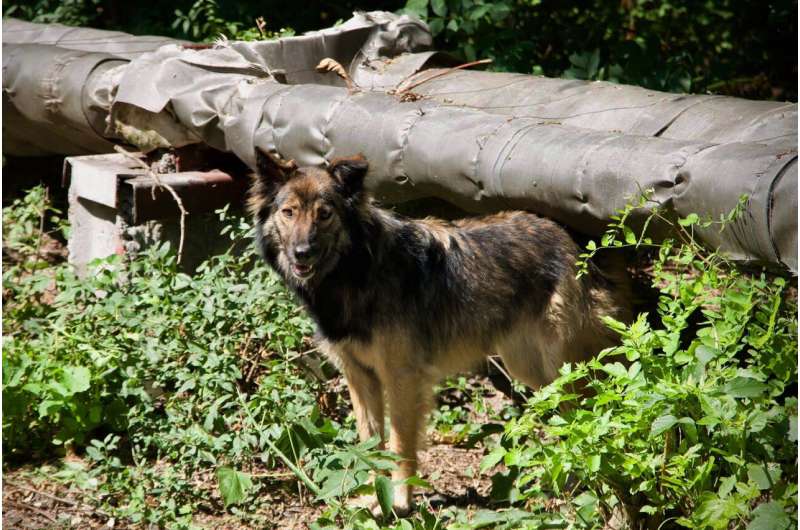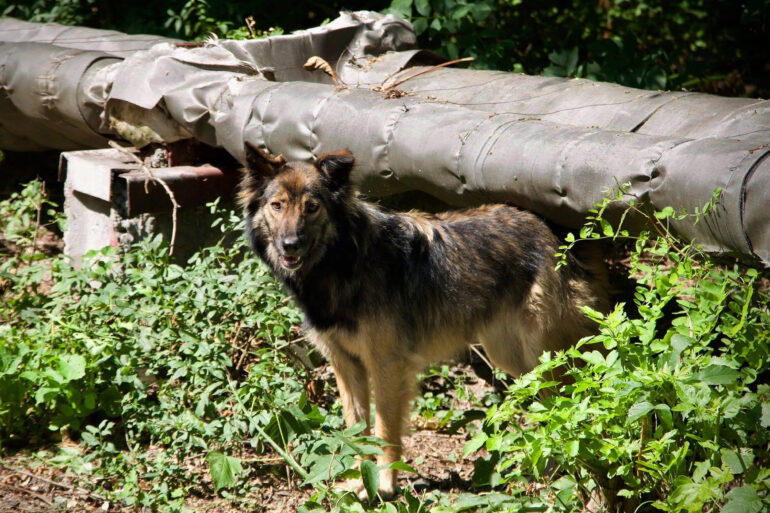More than 35 years after the world’s worst nuclear accident, the dogs of Chernobyl roam among decaying, abandoned buildings in and around the closed plant—somehow still able to find food, breed and survive.
Scientists hope that studying these dogs can teach humans new tricks about how to live in the harshest, most degraded environments, too.
They published the first of what they hope will be many genetics studies on Friday in the journal Science Advances, focusing on 302 free-roaming dogs living in an officially designated “exclusion zone” around the disaster site. They identified populations whose differing levels of radiation exposure may have made them genetically distinct from one another and other dogs worldwide.
“We’ve had this golden opportunity” to lay the groundwork for answering a crucial question: “How do you survive in a hostile environment like this for 15 generations?” said geneticist Elaine Ostrander of the National Human Genome Research Institute, one of the study’s many authors.
Fellow author Tim Mousseau, professor of biological sciences at the University of South Carolina, said the dogs “provide an incredible tool to look at the impacts of this kind of a setting” on mammals overall.
Chernobyl’s environment is singularly brutal. On April 26, 1986, an explosion and fire at the Ukraine power plant caused radioactive fallout to spew into the atmosphere. Thirty workers were killed in the immediate aftermath while the long-term death toll from radiation poisoning is estimated to eventually number in the thousands.
Researchers say most of the dogs they are studying appear to be descendants of pets that residents were forced to leave behind when they evacuated the area.
Mousseau has been working in the Chernobyl region since the late 1990s and began collecting blood from the dogs around 2017. Some of the dogs live in the power plant, a dystopian, industrial setting. Others are about 9 miles (15 kilometers) or 28 miles (45 kilometers) away.

This photo provided by Timothy Mousseau in Feb. 2023 shows a dog in the Chernobyl area of Ukraine. More than 35 years after the world’s worst nuclear accident, the dogs of Chernobyl roam among decaying, abandoned buildings in and around the closed plant – somehow still able to find food, breed and survive. © Jordan Lapier via AP
At first, Ostrander said, they thought the dogs might have intermingled so much over time that they’d be much the same. But through DNA, they could readily identify dogs living in areas of high, low and medium levels of radiation exposure.
“That was a huge milestone for us,” said Ostrander. “And what’s surprising is we can even identify families”—about 15 different ones.
Now researchers can begin to look for alterations in the DNA.
“We can compare them and we can say: OK, what’s different, what’s changed, what’s mutated, what’s evolved, what helps you, what hurts you at the DNA level?” Ostrander said. This will involve separating non-consequential DNA changes from purposeful ones.
Scientists said the research could have wide applications, providing insights about how animals and humans can live now and in the future in regions of the world under “continuous environmental assault”—and in the high-radiation environment of space.
Dr. Kari Ekenstedt, a veterinarian who teaches at Purdue University and was not involved in the study, said it’s a first step toward answering important questions about how constant exposure to higher levels of radiation affects large mammals. For example, she said, “Is it going to be changing their genomes at a rapid rate?”
Researchers have already started on the follow-up research, which will mean more time with the dogs at the site about 60 miles (100 kilometers) from Kyiv. Mousseau said he and his colleagues were there most recently last October and didn’t see any war-related activity. Mousseau said the team has grown close to some dogs, naming one Prancer because she excitedly prances around when she sees people.
“Even though they’re wild, they still very much enjoy human interaction,” he said, “Especially when there’s food involved.” ___
The Associated Press Health and Science Department receives support from the Howard Hughes Medical Institute’s Science and Educational Media Group. The AP is solely responsible for all content.
More information:
Gabriella Spatola et al, The dogs of Chernobyl: demographic insights into populations inhabiting the nuclear exclusion zone, Science Advances (2023). DOI: 10.1126/sciadv.ade2537. www.science.org/doi/10.1126/sciadv.ade2537
2023 The Associated Press. All rights reserved. This material may not be published, broadcast, rewritten or redistributed without permission.
Citation:
Can the dogs of Chernobyl teach us new tricks on survival? (2023, March 3)
